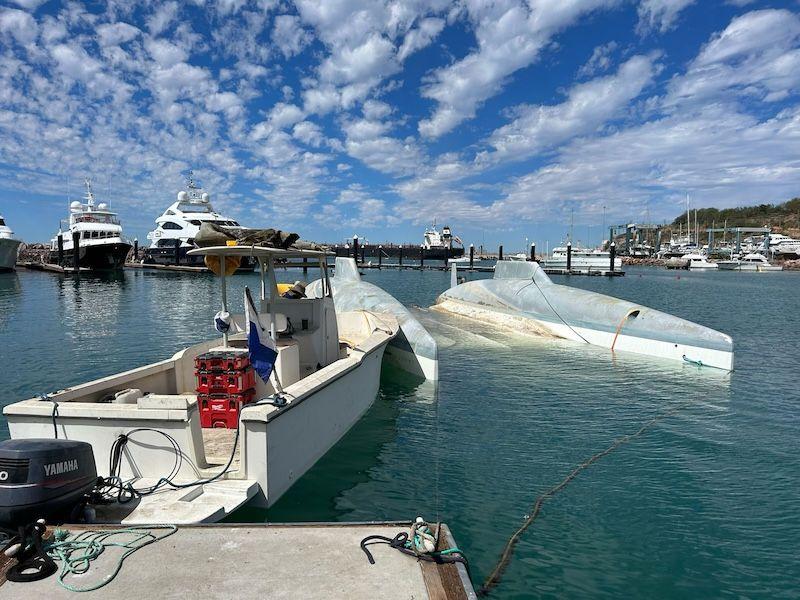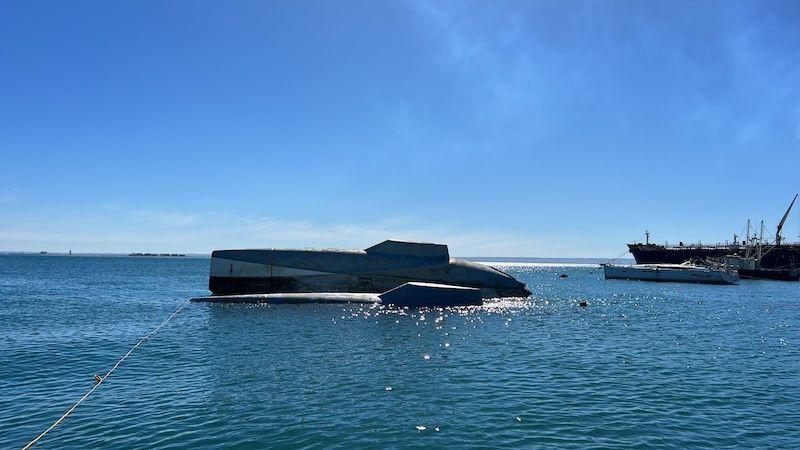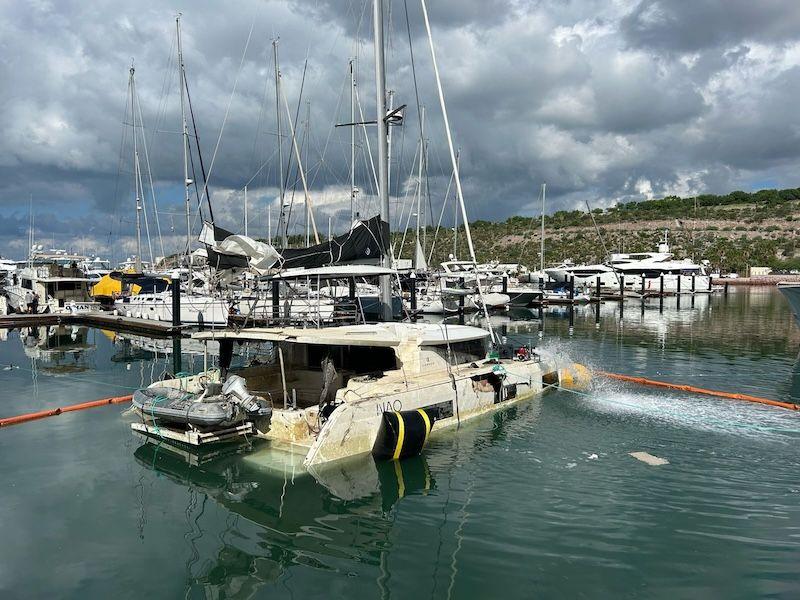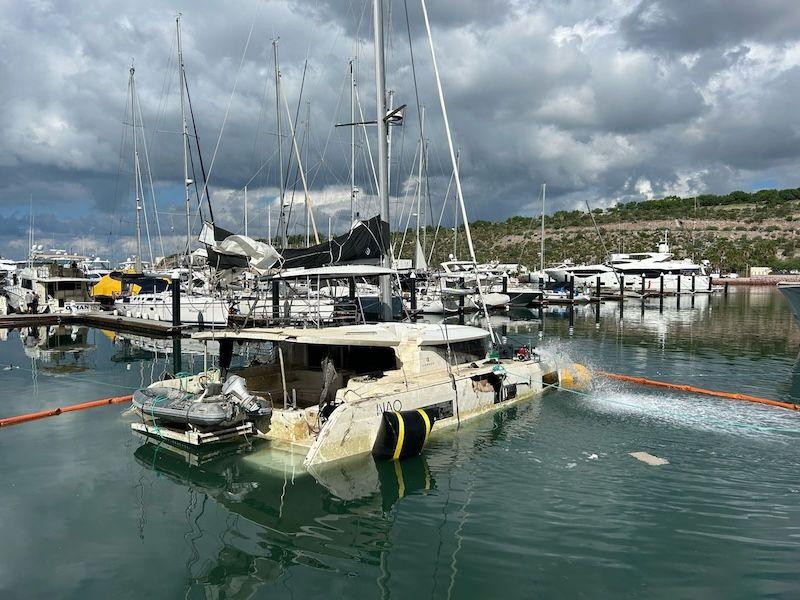On October 21, 2023, hurricane “Norma” directly impacted the municipality of La Paz, in Baja California Sur. Once the damage count began, authorities and citizens became aware of the size of the catastrophe that occurred in the bay: a yacht cemetery.
The events aroused the concern of civil society. Information flowed by a droplet and the Mexican Center for Environmental Law (Cemda) intervened. The regional director, Mario Sánchez Castro, confirmed that they filed a popular complaint with the Federal Attorney's Office for Environmental Protection (Profepa).
The complaint, with file number PFPA/10.7/2C.28.2/0140-23, was intended to urge the authority to implement the National Hydrocarbon Contingency Plan, which must be established in the event of any risk of spilling fuel into the sea.
Marine diversity, the connection with the Whale Shark Sanctuary, tourism, fishing and aquaculture productivity made several sectors aware of the risk posed by subsidence.
While state and municipal authorities argued that it was not a problem within their competence, Profepa confirmed dozens of boats sunk in the cove after the hurricane.
Through a request for information for this report, Profepa responded that the route of October 31, 2023 ruled out that any of the submerged vessels are in a Protected Natural Area (ANP).
“No damage to wild flora and/or fauna, fish mortality, spillage of any type of hydrocarbons, or characteristic odors of hydrocarbons, iridescence in bodies of water, or the accumulation of municipal solid waste derived from stranding and/or refloating of these vessels,” the federal institution reiterated.
The response, far from convincing civil society, increased alerts. Specialists in the field of environmental preservation warned that it was impossible for the authority to confirm in eight days that there was no damage to the ecosystems of the bay without a specialized study.
Inability to inspect and monitor
In an interview for this report, the regional director of Cemda, Mario Sánchez Castro, clarified that this problem is not reviewed, sanctioned or addressed by the General Law on Ecological Balance and Environmental Protection (LEGEEPA), but through maritime regulation.
“The maritime authority should have these determinations about how a ship enters, how it is parked, how long it can stay and what should happen in times of accidents,” he said.

Photo: SM Diving & Salvage.
Without the above, it is a circle made up of the lack of inspection and surveillance capacity in the cove.
“When you enter the bay, someone should check that you meet the requirements, otherwise you shouldn't be there because then these things happen. It's happening, it's going to keep happening...”, reiterated the director.
“As is often the case with environmental issues and others, a small part of things is up to different authorities and a single law will not solve it for you,” he added.
Plans and agreements must be given in a transparent way, a need for institutional action that doesn't happen, according to testimonies from activists and businessmen.
But despite the number of vessels that were sunk by Hurricane Norma, federal authorities did not see it necessary to implement the Hydrocarbon Spill Emergency Plan.
The need for an oiled system became evident since the environmental disaster occurred in Balandra in August 2022, when a yacht caught fire in the Protected Area of Flora and Fauna (APFF).
The accident caused a spill of fuel and slag from the maritime unit, which resulted in a catastrophe that kept the most visited and emblematic beach in La Paz closed for more than two months.
Since then, civil society organizations have denounced the absence of inter-institutional work and the lack of intention and capacity of bodies, such as the National Commission for Protected Natural Areas (Conanp), to make the facts transparent and the progress in the recovery of this space, which is a symbol of the struggle for the conservation of the heritage of South Californians.
The wreckage of this boat was brought afloat 12 days after the incident, under the supervision of the Secretariat of the Navy and Profepa, however, during the transfer of the boat to the capital's Marina, it sank again.
Now outside Balandra Bay, at the bottom of the sea in La Paz, the remains of the boat called “Fortius” remain, without the authorities trying new maneuvers to remove them.
Mario Sánchez stressed that environmental issues are not exclusive to the federation and that it is something that falls within the competence of all authorities at the three levels of government.
“What I do know is that there should be a joint plan that obviously doesn't exist,” he stressed.
That is why it suggests the need for a regulation such as the Urban Development Plan (PDU), which serves to manage and organize maritime traffic in the bay and in which various authorities are involved.
“The bay involves issues of priority species, fishing, tourism, recreation, there's a lot there and there's no structured plan,” he recalled.
According to the list of 40 boats provided by Profepa, most of the sunken units were sailboats.
The lawyer pointed out that we should not only focus on fuel, but also on the mechanical, fiberglass and electronic parts that make up these vessels and that are also factors of pollution.
“Fuel is like the most common thing and there is a regulation for this, but also leaving a battery in the water, if your radio has electronic components that may have an interaction of rust or other minerals, we have already seen that a battery should not enter the water, imagine a battery that can have an electrical light system,” he said.
The risk of contamination

Photo: SM Diving & Salvage.
The authorities maintain that since there is no oil spill, the situation is “under control”, however, specialists warn that there is a risk of contamination due to various factors.
Research professor and master of science Marco Antonio Medina López states that when a structure enters the sea, three things can happen: a positive impact, a negative impact or no consequence.
He argues that introducing or simply leaving units on the seabed is not appropriate because of the contamination in plastics, hydrocarbons and other chemical substances that may be in ships and whose existence is unknown until they react at sea.
“I think that it would not be appropriate to put boats directly into the sea, in order to stop there being visual pollution, in the long run they would cause more harm than good to the marine ecosystem,” he said.
Regarding the positive impact, he highlighted the concentration of organisms, however, it has already been documented that not all living beings that “stick” to artificial reefs benefit the ecosystem and that they do not always have a biological impact on the area. There are fish that enter their reefs, but that's not a lot and they only use them as a shelter while they're not hunting.
He recalled that within artificial reefs there is a great variety, one type that was being used since the Second World War was the sinking of ships in order to convert them into structures for a conglomeration of organisms and for recreational activities such as diving.
It was accepted at the time, however, these ships were completely cleaned without leaving structures that could become polluting, a situation that is not the case with sailboats and yachts in the bay.
On the other hand, he stressed that it is impossible for sunken vessels not to have any type of hydrocarbon, after a sinking the fuel begins to pollute.
The researcher stressed that the fact that this pollution is not visible to the naked eye is normal due to the currents that occur, especially in this part of the cove of La Paz, inside a channel that enters and leaves water twice a day 365 days a year.
There are other types of materials, such as plastics, that break up very easily. They do not decay, they are pulverized, which forms microplastic contamination.
“It's a big scientific topic right now, because microplastics have a big impact on food webs, because they're eaten by small fish larvae and other invertebrates and they feel that they're full even if they're not full. So, they starve to death even though they're eating, because of those particles that are pouring into the environment,” he said.
He also added to the list the presence of heavy metals in some substances. There are many yachts that use mercury thermometers, a highly harmful metal contaminant.
Profepa's answer
Through an email, Profepa was questioned about the general situation of the ecosystem after this event occurred. The federal authority responded to a questionnaire, in which it confirmed that there was no damage or spill of hydrocarbons, dated November 1, 2023.
It corroborated the popular complaint PFPA/10.7/2C.28.2/0140-23, which was admitted and resulted in technical visits to Natural Resources and industrial inspections.
“Most of the boats were stranded close to the place where they were anchored, so there is no significant impact on marine species,” the authority insisted.
Profepa assured that the disaster in the bay did not affect the whale shark because the winds from the north had not yet arrived, which is what attracts the currents, which provide zooplankton, which is an important food for the largest fish in the world.
“In addition, due to the effect on water clarity and water pollution, whale sharks refrain from approaching contaminated water, because they are animals that filter for food. So they wouldn't get close right now,” the agency replied.
Authorities recognize the lack of regulation

Photo: SM Diving & Salvage.
“Yes, it's a major problem,” are the words of the office manager of the Semarnat representative office in Baja California Sur, Raúl Rodríguez Quintana, who recognizes the need for greater regulation in the cove of La Paz.
He assured that there is integration of several institutions, such as the Port Authority, the Secretariat of Communications and Transportation, the Navy, Profepa, Semarnat and the Federal Maritime Terrestrial Zone (Zofemat).
“All of these institutions have been holding meetings, first to warn owners that this activity of removing boats is practically the owner's responsibility,” he said.
“Many owners were not responsible for removing them, obviously a period has to be respected, I think it's three months. We must respect them in the sense that, if the individual is not held responsible, then the institutions and the Government, through an administrative procedure, already have the right or competence to be able to remove these vessels,” he explained.
So far, according to the official, almost 50% of the boats have been removed and, he estimates, there are about 17 units left at the bottom of the bay.
“I think it is important that these vessels be completely removed, not only because of the image but because of the pollution they can cause,” he acknowledged.
The Navy and Harbor Master coordinate not only to remove them, but to see where they will be placed.
“From the impact study, through Profepa, we have approached their analyses that they have done over time, there are no particular effects on diesel and gasoline, fortunately those events did not happen,” he insisted.
As a result, the Harbor Master works on a register of vessels, with registration, serial number, names of owners and units.
This, according to the representative of Semarnat, since they detected units that enter the cove and do not register their arrival. For this reason, he warned that the idea is that the owners of any boat, sailboat, yacht or boat that is not regulated, will have to do so or, otherwise, they will have to leave the cove.
“They stay there for a while, some for months and others permanently. It's one of the things that the hurricane left behind: normalizing and ordering the presence of vessels,” he concluded.
Nautical business sector in abandonment
Although the head of Semarnat assured that there is coordination and direct link with the business sector, those who keep the nautical sector afloat in La Paz have “other data” and accuse that there is no constant monitoring before, during and after a hurricane contingency.
They agree on the need to build a new marina in La Paz, however, where they place special emphasis on the absence of communication channels with the authorities and the community.
According to businessmen in the sector, towing, refloating and taking a vessel that sank out of the sea can cost between 2,000 and 5,000 dollars.
The use of a crane alone can cost between 800 and 1,200 dollars, what varies is the work to refloat the unit, because sometimes it is necessary to dive to install air bags in the surrounding area to rise to the surface.
Cindy Espinoza, owner of Baja Yachts, a nautical services and management company, commented that the impact of hurricane “Norma” was very particular because of the way in which the winds hit.
This exposed the ignorance of owners in the broadest sense, both people who work in formal companies and those who own boats and live in the bay with special permits suffered from institutional negligence and omissions.
“That they had pre-established protocols, that they knew some of the things that can or cannot be done in a natural phenomenon like the one we live in,” Espinoza recommended.
The people of La Paz know about the natural protection of the bay against hurricanes, but now, with this background, the city is not exempt from suffering another similar onslaught, which could mean a relapse in the process of the post-hurricane uprising of the city.
Data from the National Water Commission (Conagua) confirm that Baja California Sur is the entity with the highest percentage of hurricane impact in the Mexican Republic.
Records from 1971 to 2020 indicate that, on average, 5.4 cyclones enter land each year, 17% of which hit some South California area.
From the perspective of boat owners, not only were there economic and material losses due to the natural disaster, but there were also robberies and robbery of the stranded vessels, which is a symptom of the authorities' inability to respond.
Issues involving a series of permits in Semarnat, in the Port Authority, State and Municipal Civil Protection; but at no time was there advice on these procedures, they accused.
“Without a doubt, natural phenomena cannot be avoided, but I think that most people who dedicate themselves to the sea in La Paz agree that much more communication is necessary, that appropriate communication channels are generated,” Espinoza said.
*This article was produced with the support of the Network of Journalism of the Sea and Causa Natura Media.



Comentarios (0)